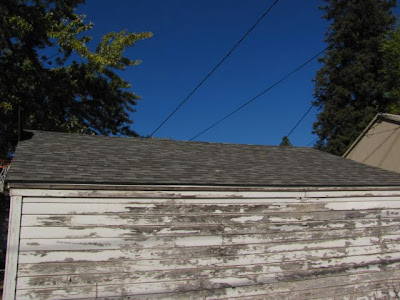 That's the new roof on the garage of our lovely rental home in Washington State. Looks great doesn't it? Yea, but there is this problem ...
That's the new roof on the garage of our lovely rental home in Washington State. Looks great doesn't it? Yea, but there is this problem ... My friend Lisa has a very intelligent father who has been in the business of developing property his entire life. And Fred is about to turn 91 in October, his entire life has encompassed a great deal. When Lisa told him the on-going fantastic tales of the trials my sister and I have been having with our slums, I mean, our rental property in the Great Northwest, like the Great Buddha, Fred spoke one maxim: "Never own investment property more than an hour's drive from your house."
In our last episode of our Adventures of The Rental Property That Ate Our Savings, my sister and I had fired the property manager whom we felt had been ripping off our father for twenty years. That was even before we saw the disreputable state into which the property had fallen.
In August, we flew to Pine Cone City to meet the new manager we had hired, both almost had heart attacks when we saw the property. Recovered and began to hire people to make the appropriate repairs and flew home, feeling we were on our way to new heights of safe, sane, fair, responsible and intelligent landlordship.
Not.
Our new manager just arranged for us to put a new roof on one of the houses, where it appeared the roof on the garage and the house might collapse with the first heavy snow up there. (And it snows up there very heavily each winter.) And instead of making things better, we have already made them worse! Our manager, as luck would have it, hired an unlicensed contractor, who installed an illegal roof without a permit!
I know this, because the inspector from Pine Cone City just called me and said if we didn't make things right we would be subject to fines and probably be sent to prison for life.
I called my sister and conceded defeat.
"How would you feel about calling a realtor and putting these turkeys up for sale?" I asked, knowing how pathetic the sales prospects are in this horrible market.
"I was hoping you would say that," she said. "How soon can we start?"
The moral of our story is that the "property management business" seems to be a euphemism for "stealing money from people who own investment property more than an hour's drive from their homes."
Finding an honest property manager is apparently even harder than finding an honest politician, or an ethical investment banker. Or a Republican journalist.
So I just want you to know that I can make you a very good deal on two lovely, but slightly derelict homes in Pine Cone City, Washington. Fixer-uppers. Handyman specials. All discounts apply. Owners must sell because they are having nervous breakdowns.
Gotta go. Police are at the door with a Code Enforcement Warrant ...
 But your honor, how was I to know the Fly-By-Night Roofing Co. had a bad reputation?
But your honor, how was I to know the Fly-By-Night Roofing Co. had a bad reputation?










































